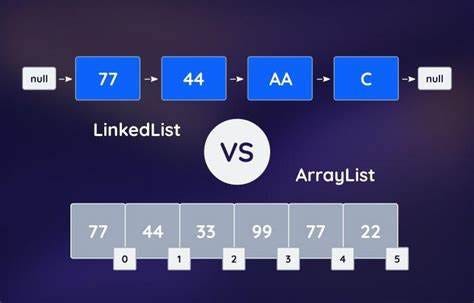ArrayList vs. LinkedList: Which is Better for Large Data Sets? 🤔Strategic Use of ArrayList and LinkedList for Large Datasets
How to Strategically Implement ArrayList and LinkedList for Optimal Performance
When working with large datasets, picking the right list implementation is crucial for performance and efficiency. The two main options are ArrayList and LinkedList. Each has its own benefits and drawbacks. This guide will help you understand how they work, their performance differences, and the best ways to use them with large amounts of data.
1. Working and Performance
ArrayList:
Working: An ArrayList uses a dynamically resizable array to store elements. When the current array reaches its capacity, it creates a new array with a larger size (typically double the previous size) and copies the elements to the new array.
Retrieve Time: Direct indexing (arrayList.get(index)) is O(1), making it very fast for random access. This is beneficial for applications where you frequently access elements by their index.
LinkedList:
Working: A LinkedList uses a doubly linked list where each node contains references to the previous and next nodes. This allows for efficient insertions and deletions.
Retrieve Time: Retrieving elements involves traversing the list from the beginning or end, resulting in O(n) time complexity. This can become a bottleneck with large datasets.
Insertion/Deletion: Insertion and deletion operations are efficient (O(1)) when the node reference is known. This makes LinkedList suitable for applications that frequently modify the list.
2. Performance Comparison:
Insertion Time:
ArrayList: Insertion and deletion operations, particularly at the beginning or in the middle, can be costly (O(n)) due to the need to shift elements. However, appending elements to the end of the list is generally efficient.
ArrayList<Integer> arrayList = new ArrayList<>(); long startTimeArray = System.nanoTime(); // Adding a large number of elements for (int i = 0; i < 99999; i++) { arrayList.add(0,i); } System.out.println("ArrayList insertion time: " + (System.nanoTime() - startTimeArray) + " ns");
LinkedList: Handles insertion and deletion operations efficiently (O(1)) if the node reference is known, due to pointer adjustments. This makes it suitable for scenarios with frequent modifications
LinkedList<Integer> linkedList = new LinkedList<>(); long startTimeLinked = System.nanoTime(); // Adding a large number of elements for (int i = 0; i < 99999; i++) { linkedList.addFirst(i); } System.out.println("LinkedList insertion time: " + (System.nanoTime() - startTimeLinked) + " ns");COMPARE OUTPUT: ArrayList insertion time: 414304700 ns LinkedList insertion time: 7456800 ns
Retrieve Time:
ArrayList
long startTimeArray1 = System.nanoTime(); for (int i = 0; i < 99999; i++) { arrayList.get(i % arrayList.size()); } System.out.println("ArrayList access time: " + (System.nanoTime() - startTimeArray1) + " ns");LinkedList
long startTimeLinked1 = System.nanoTime(); for (int i = 0; i < 99999; i++) { linkedList.get(i % linkedList.size()); } System.out.println("LinkedList access time: " + (System.nanoTime() - startTimeLinked1) + " ns");COMPARE OUTPUT: ArrayList access time: 467800 ns LinkedList access time:3241709200 ns
3. Choosing the Right List Implementation
When to Use ArrayList
Scenario: Frequent retrieval of elements by index, stable or infrequent size changes.
Example: Implementing a cache where quick lookups are needed.
When to Use LinkedList
Scenario: Frequent insertions and deletions, particularly in the middle of the list.
Example: Implementing a queue where elements are frequently added and removed.
4. Advanced Considerations
Thread Safety
Neither ArrayList nor LinkedList is synchronized. For concurrent use, consider:
Collections.synchronizedList: Wraps the list to provide synchronized access.
CopyOnWriteArrayList: A thread-safe variant of ArrayList suitable for read-heavy scenarios.
ConcurrentLinkedDeque: A concurrent alternative to LinkedList that supports efficient concurrent access.
Conclusion
Both ArrayList and LinkedList offer distinct advantages depending on the requirements of your application:
ArrayList is optimal for scenarios requiring fast random access and where insertions and deletions are infrequent.
LinkedList excels in scenarios involving frequent insertions and deletions, particularly where access times are less critical.
If you found this post helpful, consider subscribing for more updates or following me on LinkedIn, and GitHub. Have questions or suggestions? Feel free to leave a comment or contact us. Happy coding!!


